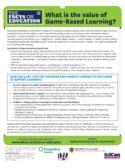What is the value of Game-Based Learning?
Download the Fact Sheet! (368.02 kB / pdf)
DownloadPlaying and designing games have been of interest to K-12 educators as ways to support student learning. Parents are also increasingly accepting of video and board games as their choice of family activity, based on a 2018 survey by the Entertainment Software Association of Canada finding that 71% of Canadian parents play video games with their children. Game-Based Learning involves learning situations where children play or design games – whether digital, physical, or table-top games – in which they solve problems and gradually develop new knowledge and skills. Games have been found to improve students’ motivation and cognitive development, such as memory and reasoning.
Key elements of Game-Based Learning include:
- Students working towards a goal, making decisions, and experiencing the consequences of those decisions. For example, the primary objective of the game ‘Monopoly’ is to own as much property and to have the most money by the end of the game, make financial-related decisions including managing money and deciding to sell/purchase property, and experience the consequences of paying rent when landing on other player’s properties, paying loans/taxes to the bank, losing your property if unable to make payments;
- Different approaches such as playing games, modifying games, and designing games; and
- Games being easy to learn and interesting to the learner (e.g. ‘Inversé’ is a game with only a few rules and colourful wooden pieces, yet can be highly interesting while supporting spatial thinking: volume, estimation, mental rotation).
HERE ARE 3 KEY TIPS FOR TEACHERS AND PARENTS LOOKING TO USE GAMES TO SUPPORT LEARNING:
- You don’t have to be an expert at playing games: Students may have better gaming skills. However, it’s important to remember that as a teacher and/or parent, it’s not essential for you to master the game, but rather to play it for yourself (or with your child) so that you can understand how it might align with targeted learning goals.
- Make connections to other subjects: While students learn many things through playing games (i.e. rules, strategies), they can also learn about a variety of subject areas through the social interactions involved (e.g. how shifting allies or enemies changes political and economic relationships, in the videogame ‘Civilization’).
- Facilitate a redesign project to encourage creativity and critical thinking by:
-
- Encouraging students to change specific game elements (e.g. game rules, number of players, the dimensions or shapes of the game board or pieces)
- Reimagining the game by changing the storyline (e.g. creating new characters, changing setting, and creating new challenges for players)
- Changing the game structure (e.g. changing the game goal, making the game based on strategy instead of chance)
- Making a new game by integrating two different existing games (e.g. combining the games ‘Inversé’ and ‘Connect 4’)
Research demonstrates that Game-Based Learning enhances essential life skills that are foundational to a child’s development. In particular, Game-Based Learning provides students with an interactive learning experience where they have the opportunity to use and develop many different cognitive, social, and physical skills. Problem solving, critical thinking, strategy development, decision making, and teamwork are some of the many skills that games can provide.
Additional Information and Resources
- Game for Change (Games for making real-world impacts): http://www.gamesforchange.org
- Math Pickle (Puzzles and Board Games for Problem-Solving): http://mathpickle.com
- MIT developed educational games (integrating science and math curricula): https://education.mit.edu/project-type/games/
- Edutopia (Tips for Game-Based Learning): https://www.edutopia.org/topic/game-based-learning
References
Clark, D. B., Tanner-Smith, E. E., & Killingsworth, S. S. (2016). Digital games, design, and learning: A Systematic review and meta-analysis. Review of Educational Research, 86(1), 79–122. https://doi.org/10.3102/0034654315582065
Entertainment Software Association of Canada. (2018). Essential facts about the Canadian video game industry 2018. http://theesa.ca/wp-content/uploads/2018/10/ESAC18_BookletEN.pdf
Gee, J. P. (2008). Learning and Games. In K. Salen (Ed.), The ecology of games: Connecting youth, games, and learning(pp. 21–40). MIT Press. https://mitpress.mit.edu/books/ecology-games
Jaques, S., Kim, B., Shyleyko-Kostas, A., & Takeuchi, M. A. (2019). “I Just won against myself!”: Fostering early numeracy through board game play and redesign. Early Childhood Education, 26(1), 22–29. http://hdl.handle.net/1880/111252
Kim, B., & Bastani, R. (2017). Students as game designers: Transdisciplinary approach to STEAM Education. Special Issue of the Alberta Science Education Journal, 45(1), 45–52. https://sc.teachers.ab.ca/SiteCollectionDocuments/ASEJVol45No1November2017.pdf
Kim, B. & Bastani, R. (2018). How Inversé merged with Go: (re)designing games as mathematical and cultural practices. In Proceedings of the 5thInternational STEM in Education Conference (pp.166-172). Brisbane, Australia: Queensland University of Technology. https://stem-in-ed2018.com.au/proceedings-2/
Koabel, G. (2017). Simulating the ages of man: Periodization in Civilization V and Europa Universalis IV. The Journal of the Canadian Game Studies Association, 10(17), 60-76. https://journals.sfu.ca/loading/index.php/loading/article/view/192
Sardone, N. B., & Devlin-Scherer, R. (2016). Let the (Board) Games Begin: Creative Ways to Enhance Teaching and Learning. The Clearing House: A Journal of Educational Strategies, Issues and Ideas, 89(6), 215–222. https://doi.org/10.1080/00098655.2016.1214473
Squire, K. (2006). From content to context: Videogames as designed experience. Educational Researcher, 35(8), 19–29. https://doi.org/10.3102/0013189X035008019
Qian, M., & Clark, K. R. (2016). Game-based learning and 21st century skills: A review of recent research. Computers in Human Behavior, 63, 50–58. https://doi.org/10.1016/j.chb.2016.05.023
Zimmerman, E. (2009). Gaming literacy: Game design as a model for literacy in the twenty-first century. The video game theory reader, 2(23-32). http://www.neliufpe.com.br/wp-content/uploads/2014/02/08.pdf

